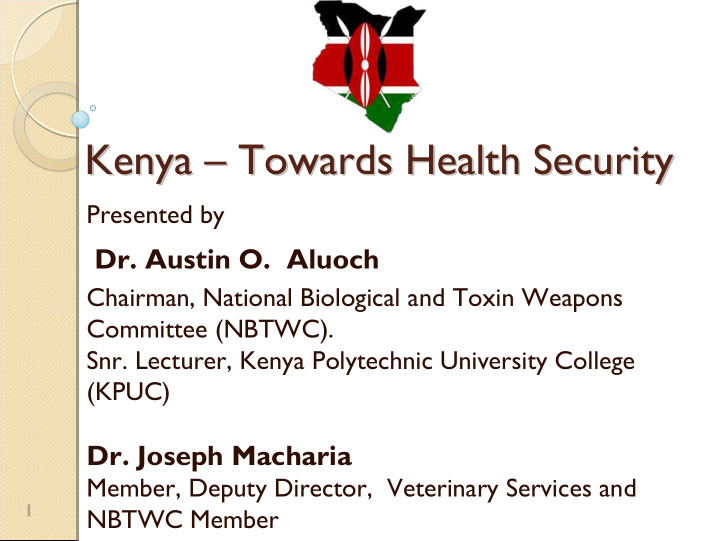



Kenya – – Towards Health Security Towards Health Security Kenya Presented by Dr. Austin O. Aluoch Chairman, National Biological and Toxin Weapons Committee (NBTWC). Snr. Lecturer, Kenya Polytechnic University College (KPUC) Dr. Joseph Macharia Member, Deputy Director, Veterinary Services and 1 NBTWC Member
Disclaimer Disclaimer � The views, opinions, findings, and The views, opinions, findings, and � conclusions expressed in this presentation conclusions expressed in this presentation are those of the author and do not are those of the author and do not necessarily represent the views, official necessarily represent the views, official policy or position of the Government of policy or position of the Government of Kenya or its components Kenya or its components 2
Kenya Kenya � Located in East Africa � Boarders ◦ Somalia ◦ Uganda ◦ Tanzania ◦ Ethiopia ◦ Sudan � Has an area of 583,000 km 2 3
� The Government of Kenya recognizes ◦ there is NO single technology or process that can deter the application of a biological agent (BA) or toxin � Since the effects of BA manifest as disease � And diseases don’t recognize boarders or need visas � International Partnerships in countering biological threats (whether natural, accidental or deliberate in nature) remain the best strategies in achieving health security 4
� Therefore the implementation of international instruments for non- proliferation e.g. ◦ Biological Weapons Convention, ◦ United Nations Security Council Resolution 1540) ◦ WHO’s International Health Relations ◦ as well as the establishment of regional and international partnerships � is of the essence � Essentially the Web of Prevention 5
The Web of Prevention The Web of Prevention 6
Africa and the BWC Africa and the BWC � Despite 36 yrs since the BWC entered into force (BWC) the majority of African States Parties yet to implement effective national measures to ensure compliance with Convention obligations � The majority of States Parties that have not ratified the BWC are in Africa 7
� There are 13 signatories (have not ratified): 8 from Africa – ◦ Burundi, Central African Republic, Côte d'Ivoire, Egypt, Liberia, Malawi, Somalia, Republic United Republic of Tanzania � NON State Parties - 9 from Africa ◦ Angola, Cameroon, Chad, Comoros, Djibouti, Eritrea, Guinea, Mauritania, Mozambique, Namibia � Could be due to ◦ Other priorities – poverty, disease, food insecurity 8
Kenya and the BWC Kenya and the BWC � Kenya acceded to the BWC in January 1976 � Not much participation in the BWC activities until 2008 � After which a need to establish an effective National focal Point was realized � In 2009 the National Council for Science and Technology (NCST) was established as the focal point 9
10
11
The NBTWC The NBTWC � National Implementation of the BWC ◦ Drafting relevant legislation � Matters pertaining to Biosecurity and Dual Use � Representing Kenya in the BWC Meeting of States Parties (MSP) and Meeting of Experts (MX) � Compiling and submitting the Confidence Building Measure (CBM) Forms 12
NBTWC Achievements NBTWC Achievements � Drafted the National Biosecurity Policy ◦ With stakeholders inputs � Drafted the National Biosecurity Bill ◦ Awaiting stakeholder input 13
NBTWC Achievements NBTWC Achievements � Made country statements and presentations at the MSP and MX � Submitted Kenya CBM’s in 2010 and 2011 � Planning a CBM workshop ◦ With assistance of EU joint action and the ISU � Key role in the organizing a Biosafety and Biosecurity Workshop conducted by Defense Institute of Medical Operations (DIMO) USA 14
NBTWC Achievements NBTWC Achievements � Already collaborating with the US Biological Engagement Program (BEP) and Sandia National Labs (USA) on assessing and improving the management of Biorisks in Kenya ◦ Collaborative Workshop between USA and Kenya Stakeholders planned in October 2011 � Plan to hold a BWC Universalization workshop in 2012 15
Other Achievements Other Achievements � Through the Ministry of Public Health ◦ Kenya is signatory to the WHO IHR ince 2005 ◦ Kenya is implementing Integrated Disease Surveillance and Response [IDSR] strategy IDSR 16
Disease Surveillance Structure Disease Surveillance Structure Surveillance structure National Disease Surveillance National Coordinator and focal persons for EPI target diseases Provincial Disease Surveillance Provincial Coordinator District District Disease Surveillance Coordinator Health Hospital Surveillance Coordinator Facility Community focal persons (proposed) Communit y 17
Specific Goals of the IDSR Specific Goals of the IDSR � Strengthen District Level Surveillance and Response � Minimize Duplication in Reporting � Share resources among disease control programmes � Transfer surveillance and laboratory data into public health action 18
Challenges Challenges � NBTWC has no budget ◦ Challenges financing activities ◦ Operates on donor funds � Cooperation between Life Scientist, Security Agents and public Health is still lacking � Most Life Scientists are still not aware of the Dual nature of their work 19
Challenges Challenges � Biosafety/Biosecurity Education ◦ Need for vigorous outreach education programmes to raise awareness among the Life Scientists, Security Agents, public health and policy makers on Dual-Use and Biosecurity ◦ Need for curriculum development for Universities on Dual-Use- Biosecurity 20
� Lab Capacities need to be enhanced for effective disease surveillance 21
Challenges… …. . Challenges � Public health is still experiencing challenges in the full implementation of IHR/IDSR programmes � Need for more BSL-2 labs at district levels � Need for quarantine facilities ◦ At airports and entry points ◦ At national and district hospital 22
Challenges Challenges � Currently, there is no oversight authority for Dual-Use Biological Agents ( Select Agents � Need for Transportation controls Biological Materials ◦ Oversight Authority can be established at the NCST pending passing of the Bill 23
Challenges Challenges � Need for Central Command Center and dedicated response team (first responder) for Biosecurity emergencies 24
� We still have a long way to go to attain the required Biosafety and Biosecurity Status � But we are on the Right Track! 25
Acknowledgements Acknowledgements 26
Hakuna Matata ! Kenya Thank You 27
Recommend
More recommend